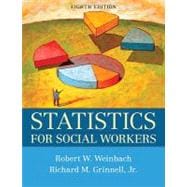Now in its eighth edition, this widely used text covers the types of statistical analyses that are most likely to be encountered by social work practitioners and researchers. It requires no prior knowledge of statistics and only basic mathematical competence.
This acclaimed statistics text requires no prior knowledge of statistics, emphasizing a conceptual understanding of the topic and its usefulness to social work practice and research. Rather than focusing on mathematical computation, Statistics for Social Workers instead focuses on providing an understanding of the logical underpinnings of statistical analysis and how to apply the results of analysis in a social work practice environment. The authors have used this approach to teaching statistics for over 25 years, and it remains the most widely used book of its kind.








